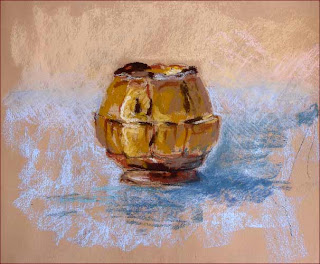 This is about 7-1/2" x 10" on very rough Saint-Armand Colours paper in a washed denim color (nice flecks in it, obviously hand mixed / hand made). I coated it with clear Colourfix primer. Then I started out with a big sloppy mess of an alcohol wash, washing in the (sort of) complementary colors to what I was intending for the finish layer.
This is about 7-1/2" x 10" on very rough Saint-Armand Colours paper in a washed denim color (nice flecks in it, obviously hand mixed / hand made). I coated it with clear Colourfix primer. Then I started out with a big sloppy mess of an alcohol wash, washing in the (sort of) complementary colors to what I was intending for the finish layer.One question is this: What's the difference among a water wash, an alcohol wash, and a wash done with Turpenoid? (And here is the answer to that question.)

















































